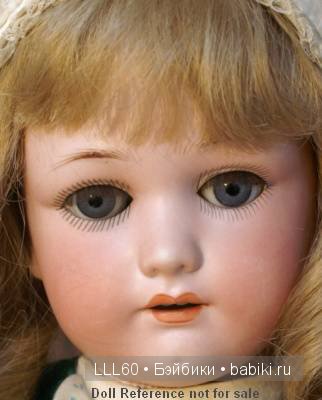or: How to distinguish a replica/fake from the original doll
The general to distinguish a replica/fake is to know what the original looks like. To do this, you need to read encyclopedias, and books, look at photographs, look at real dolls, and memorize, compare and summarize information.
1. The quality of porcelain.
In inexpensive French biscuits, especially SFBJ, or low-quality porcelain more noble firms Rabery & Delphieu small dots, and pimples are often found.


Old porcelain, oddly enough, is warmer to the touch, but this can be understood if you could get to know a real doll.
2. The color of porcelain.
Usually, the top of the porcelain head was tinted with pink flesh-colored paint. Often its streams are visible, flowing inside the head, through the eye sockets, or fingerprints at the base of the neck.


The replicas are more whitish, but sometimes they are shaded into a more beige color.

3. Painting of the face.
Puppet factories already had in-line production, it was necessary to do a lot and quickly, so the painting was fluent. The cheaper the doll, the easier it is.

The surest thing is to see as many original dolls as possible, preferably live, so that you can touch them, then the fake will catch your eye and be felt to the touch.
4. Eyes and eyelashes.
Examine the eyes themselves and their iris. Antique eyes very often have a dark rim of the iris, the pupils are not always the same size, and the sclera is milky white.



Eyelashes were invented late – in the early 1900s. In addition, the eyelashes are either from mohair, and he has already managed to fray, or from natural hair, some of which is also lost.





5. Torso.
However, there are many exceptions – different manufacturers have a different “native color”.
Look at the erased places, only two layers of coating should be visible there: varnish or paint and a whitish primer under it. More and more layers should not be.
But the ancient torso is not an indicator of the authenticity and origin of the head.




6. Wig
A wig is not an indicator of authenticity at all. But it should only be made from natural materials – human hair or mohair (woolen mohair). No rubber bands around. This was not the case before. Modern wigs hair is very even and smooth.

7. The head.
This is the most important thing in a doll. A non-native body, of course, reduces the collection value of the doll, but not fatally, as well as non-original (but still vintage) dresses or a wig.
The plaster holding the eye mechanism should be white, not pink or beige – these are already late layers. A perfectly clean head should alert, but this is also not an indicator.



If the head is dirty from the inside, and the dirt has eaten in, then it is probably really very old, and the head is at least several decades old.
Often helps the presence of chips on the lobes of pierced ears – where there are holes for earrings. Their presence gives several points to the original. Such chips practically do not affect the cost of the doll and are not considered a major defect, this is a completely normal thing.
Head molding should be appropriate for both age and type – early French biscuit heads do not have a rim, while German heads have a rim.
Late French dolls (from 1886) also have a rim that is not as wide as German dolls.
On the back of the head, there should be a marking of the manufacturer and, accordingly, the declared brand, or other signs indicating the country of origin or company.


Check if there is a signature or initials of the author – often the author of the replica honestly signs. But the author of an illegal fake does not do this
An important point is if there is a size mark on the head (numbers usually placed on the neck or at its very bottom), then you should check its compliance with the actual size of the doll. Each manufacturer has its own range of sizes, sometimes even changing over time, so this needs to be studied.
Studying photos in catalogs and albums helps a lot. And even better – personally from a collector friend, after you look at more than a dozen original antique dolls, the replicas will catch your eye.
This is important, because often in poor-quality descriptions of dolls the words “replica”, and “by artist” is mentioned somewhere from the edge, casually, or even completely silent. The puppeteer’s signature may not always be present either, because all over the world it is customary to either sign the work or attach a certificate.
Source: https://babiki.ru/blog/interesnoe-antikvarki/75608.html

Average Rating